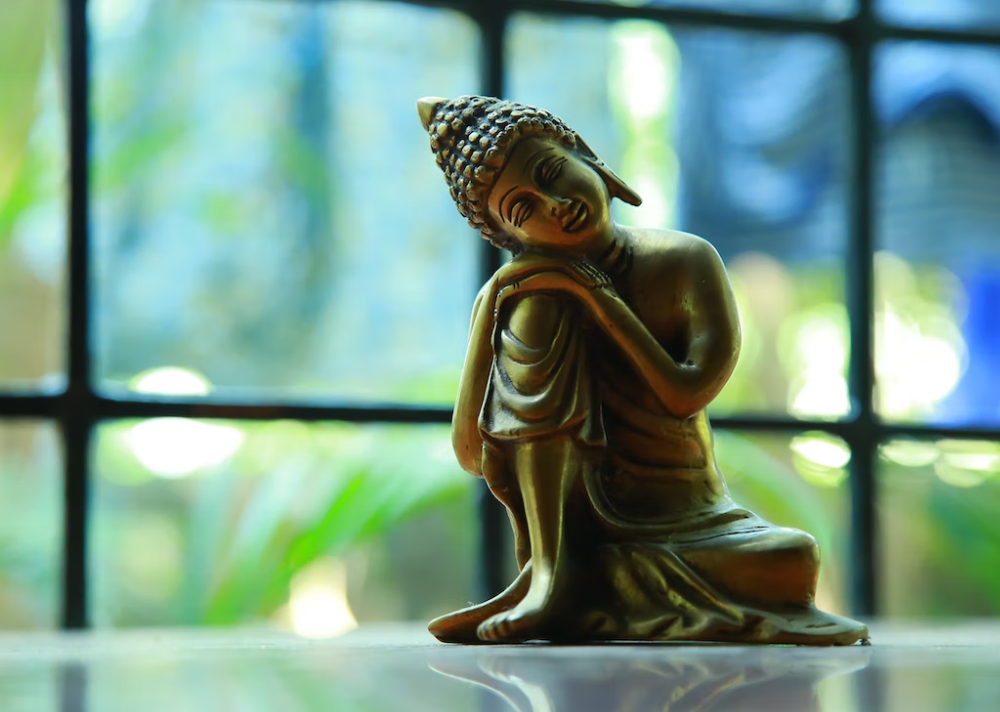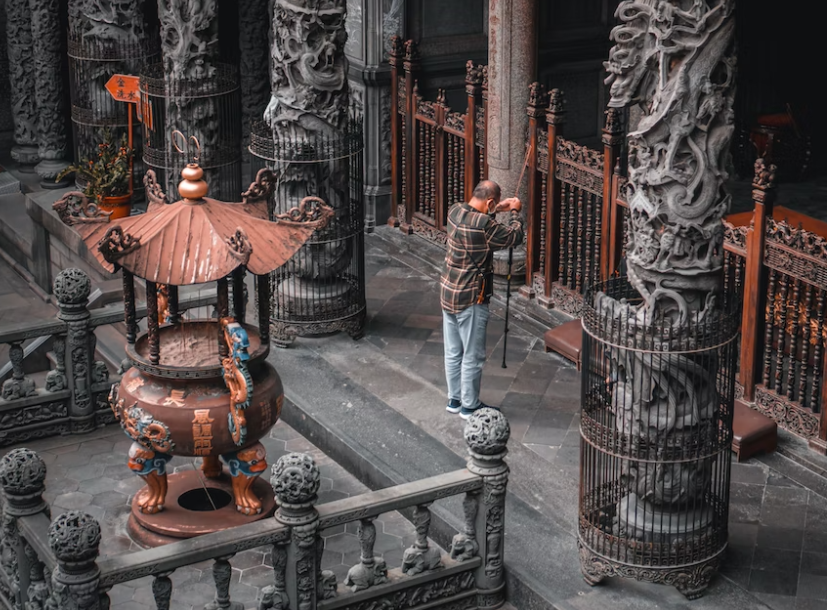Where Did Meditation Start?
Learn about the origins of meditation and its historical significance.

Selfpause Affirmation App
Download the app to get 1,000’s of affirmation meditations and everything you need to write, record and listen to your own.
Meditation is an ancient practice with an impressive history. The Hindu scriptures, for example, first mention meditation in about 1500 BC. Some historians date the practice back to 500 BC. In ancient China and India, the practice of meditation developed into Taoism and Buddhism. A philosophical text called the Bhagavad Gita describes the benefits of meditation, pointing to its ability to bring one to a higher spiritual level.
Buddhism

Buddhist meditation sometimes referred to as dhyana, is a practice of mental concentration that leads to a state of spiritual freedom. It occupies a central place in Buddhist philosophy. It combines the discipline of increased introversion with insight gained through wisdom. During meditation, one focuses on a specific object called kammatthana, which varies from person to person. Typically, there are 40 kammatthanas, or techniques, that are practiced during meditation. These techniques develop equanimity, tranquility, and insight.
Buddhism is one of the oldest religions to incorporate meditation into its teachings. The ancient teachings of meditation were first described in the Vedas, a collection of religious texts. It is believed that Siddhartha Gautama, the founder of Buddhism, learned meditation as part of the path to enlightenment. Later, Buddhism spread across Asia, and its meditation styles are practiced in many cultures, including Japan and the Western world.
The ancient practice of meditation was influenced by Jewish esotericism, which developed its own form. In the 1700s, the texts of Eastern philosophy were translated into European languages. The practice became popularized thanks to the influential Vipassana teacher, S. N. Goenka.
Meditation was only a fringe concept in the 19th century, but it has since become widely practiced. Today, health professionals use it to treat a variety of conditions. Silicon Valley programmers, professional athletes, and CEOs practice it to enhance their performance. It is also taught in schools to help students regulate their emotions and handle stress.
The word “meditation” originates from the Latin word meditate. The practice of meditation was first practiced in India and was quickly adopted by neighboring nations. Many other religions practiced meditation at some point in history. Meditation was first recorded in the Vedas, which were compiled in the 14th century BCE.
There are many definitions of meditation. In some schools of thought, it is as old as humanity. In India, the oldest-known images of meditation date back to 5000-3500 BCE. In Hindu traditions, meditative postures and closed eyes were common. In other parts of India, meditative practices are cited as far back as the 6th century BCE.
The twentieth century brought about a surge of interest in Buddhism as a form of alternative medicine. The Dalai Lama was influential in expanding the Buddhist movement. Around the same time, Theravadin centers were established in the United States. The aim of these centers was to integrate Buddhism with Western psychology and medicine.
Confucianism

Many of the earliest meditation techniques were derived from Confucianism, a philosophy that was first formulated thousands of years ago. The basic idea behind Confucianism is to live in harmony with the universe and to cultivate virtue. This is achieved by cultivating the right kind of mind, which is the key to happiness. In this way, you can improve your health, wealth, and relationships.
The practice of meditation first began during ancient times, when wandering ascetics and religious people sought to connect with transcendental forces. The Hindu tradition, meanwhile, has the oldest and largest tradition of meditation on Earth, with many Yogis living in caves and the Sages of the Vedic tradition.
While Confucius did not talk about spirits, the Neo-Confucians formulated numerous theories about the spirit world. One widely accepted view defined spirits and ghosts as spontaneous activities of the yin and yang within the world. In other words, the Neo-Confucians believed that the human mind is real and substantial.
Confucianism was born in Japan. During the early years of imperial rule, the Kamakura samurai regime promoted Confucianism as the best philosophy for the people. It became the dominant philosophy during the relatively peaceful years of imperial rule. Later affirmations of Confucianism were meant to counteract the threat of Christianity. Among the most outspoken critics of Christianity was Inoue Tetsujiro, who called Japanese Confucianism “Japan’s first philosophy.”
The Neo-Confucians were also critical of Buddhism. However, Hegel did not see Buddhism as antithetical to Confucianism. Nonetheless, he did not deny that Confucianism could be a “philosophy.” So, he did not call it “assumes” – he merely saw it as a way to understand the world.
The Chinese also learned about the importance of words in their everyday lives. Confucius believed that words were vehicles for substantial meaning and were essential to self-understanding and self-cultivation. He emphasized the importance of words in order to foster peace, prosperity, and happiness. It is no wonder that this philosophy was adopted by the ruling elites in the East Asian countries, whose intellectuals and statesmen accepted it as the most appropriate philosophical framework for modernity.
Confucius himself is said to have been an expert on the subject, editing many of the classics that would later be studied in schools. He was also an influential authority on etiquette, history, and the study of change. These texts eventually became the basis of an expanding “Confucian” curriculum.
Confucius did not see himself as founding a school of philosophy. His primary aim was to establish social order. The Zhou kingdom was a time when order prevailed and Confucius believed that this could be restored. He traveled from realm to realm hoping to find a patron to support his ideas.
In Japanese culture, the term for Confucianism is Jukyo, a Japanese term that translates to “mind work.” It refers to the idea of working with the mind. In Japanese culture, Jukyo was commonly used to describe scholars who employed their minds to study Confucius’ teachings. Jukyo also reflects Confucius’ distaste for coercive force.
Lao-Tze

The ancient Chinese philosopher Lao-Tze was the original master of meditation. He created a system and taught it to the world. He cultivated the practice himself and was enlightened by the practice. He spent his life teaching meditation and spiritual awakening. Later, Buddhism spread throughout Asia and reached the West. Buddhist-style meditation is widely practiced today.
Lao-Tze was an older contemporary of Confucius and held the official title of ‘keeper of the archives in the imperial court during the Chou dynasty. His teachings stressed the importance of maintaining virtue and guarding the One. He also emphasized the need to reduce selfishness and embrace the government of the sage. He believed that human actions polluted the universe.
Throughout history, meditation has been practiced by people of all faiths and backgrounds. It can be practiced privately or in a group. Some people practice it in religious settings, while others practice it as a form of exercise. Some forms of meditation are more physical than others, such as yoga. Body-centered meditation involves focusing on specific sensations in the body. Other forms of meditation involve contemplating a contradiction or an emotion.
Historically, meditation originated in India. The earliest evidence of meditation comes from the wall arts of the Indian subcontinent, dating from 5,000 to three thousand BCE. Its earliest written mention is in the Vedas, which were first written in the 14th century BCE. The Brihad Aranyaka Upanishad lists seventy generations of meditation gurus.
The Laozi is one of the most widely studied and translated works in world literature. Many reprints and translations have followed. It has also been considered a classic of early Chinese philosophy. However, there is no consensus as to whether or not the Laozi text is the original.
Although the Laozi is believed to be timeless and transcends cultural differences, some scholars consider it to be a timeless text, despite its historical context. In fact, some styles have been found in the Laozi text. While these styles are in poor condition, they serve as significant collaborating support to the textual critics. Several Chinese and Japanese studies make use of a significant number of manuscript versions and stone inscriptions to examine the Laozi in its historical context.
Confucius consulted Laozi on a number of ritual matters, including funeral rites. Confucius also praised Laozi lavishly for his consultations. There are several different versions of Lao-Tze’s story, with various dates suggested as the origin. It is widely believed that Laozi lived in the sixth century B.C.E., a period later known as the Warring States period.
Our Top FAQ's
The origins of meditation are difficult to trace definitively, as the practice has likely existed in various forms in many different cultures and traditions throughout history. However, some of the earliest known records of meditation come from ancient Indian traditions such as Hinduism and Buddhism.
It is likely that many different cultures and traditions practiced meditation in some form, but some of the earliest known examples come from ancient Indian traditions such as Hinduism and Buddhism. These traditions likely developed their own unique forms of meditation and used it as a means of spiritual growth and enlightenment.
Over time, the practice of meditation has evolved and adapted to different cultures and traditions. In many cases, it has been influenced by other spiritual practices and beliefs, leading to the development of a wide variety of meditation techniques and styles. Today, meditation is practiced by people all over the world, and it is often used not only for spiritual purposes, but also for its potential health benefits.
Some common misconceptions about the history of meditation include the belief that it is a recent invention, or that it is only associated with certain religious traditions. In reality, meditation has a long and varied history that spans many different cultures and traditions. It has also been shown to have potential health benefits, making it a valuable practice for people from all walks of life.
Some examples of ancient meditation techniques that are still used today include concentration meditation, where the practitioner focuses on a single object or thought; mindfulness meditation, where the practitioner focuses on the present moment; and mantra meditation, where the practitioner repeats a specific sound or phrase to themselves. These techniques have been adapted and modified over time, but they still retain their core principles and can be used effectively by modern practitioners.
